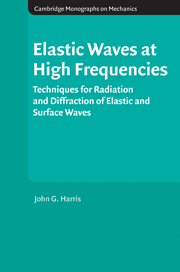 Elastic Waves at High Frequencies
Elastic Waves at High Frequencies Published online by Cambridge University Press: 05 October 2010
This chapter is concerned with cracks. Real cracks in solids are complicated: they are thin cavities, their two faces may touch, and the faces may be rough. We consider ideal cracks. By definition, such a crack is modeled by a smooth open surface Ω (such as a disc or a spherical cap); the elastic displacement is discontinuous across Ω, and the traction vanishes on both sides of Ω (so that the crack is seen as a cavity of zero volume). We suppose that we have one crack with a smooth edge, ∂Ω, embedded in an infinite, unbounded, three-dimensional solid. Extensions to multiple cracks, to cracks in two dimensions, to cracks in halfspaces or in bounded domains, or to cracks with less smoothness may be made, with varying degrees of difficulty. For a variety of applications, see the book by Zhang and Gross (1998).
After formulating our scattering problem, we give the governing hypersingular integral equation in §5.2. This equation is solved approximately for long waves (low-frequency scattering) in §5.3. The approach used is elevated to a well-known ‘strategy’ in §5.4 prior to further applications. For flat cracks and screens, we can simplify the governing hypersingular integral equation. This is done in §5.5. Alternatively, we can use a direct approach, using Fourier transforms; see §5.6. Methods for solving the resulting equations are discussed in §5.7. The final section is concerned with curved cracks and screens.
To save this book to your Kindle, first ensure no-reply@cambridge.org is added to your Approved Personal Document E-mail List under your Personal Document Settings on the Manage Your Content and Devices page of your Amazon account. Then enter the ‘name’ part of your Kindle email address below. Find out more about saving to your Kindle.
Note you can select to save to either the @free.kindle.com or @kindle.com variations. ‘@free.kindle.com’ emails are free but can only be saved to your device when it is connected to wi-fi. ‘@kindle.com’ emails can be delivered even when you are not connected to wi-fi, but note that service fees apply.
Find out more about the Kindle Personal Document Service.
To save content items to your account, please confirm that you agree to abide by our usage policies. If this is the first time you use this feature, you will be asked to authorise Cambridge Core to connect with your account. Find out more about saving content to Dropbox.
To save content items to your account, please confirm that you agree to abide by our usage policies. If this is the first time you use this feature, you will be asked to authorise Cambridge Core to connect with your account. Find out more about saving content to Google Drive.